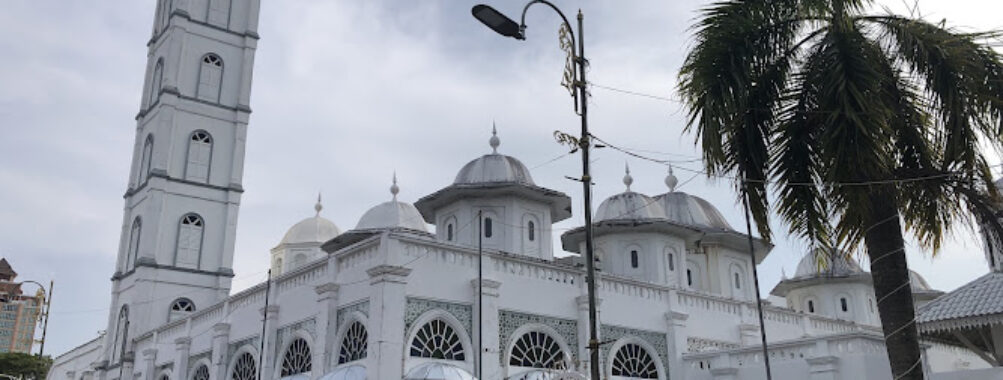
Abidin Mosque (State Mosque)
Table of Contents The Abidin Mosque, also known as Masjid Sultan Zainal Abidin or the State Mosque, stands as one of the most important and historically significant mosques in Kuala Terengganu, Malaysia. Locals often refer to it as Masjid Putih, or the White Mosque, thanks to its radiant white exterior that gleams under the tropical sun. The mosque represents both faith and heritage, telling the story of the Terengganu sultanate’s deep connection to Islam through centuries of tradition and adaptation. It’s not just a structure where prayers echo five times a day—it’s a living chapter of Malaysia’s religious and cultural evolution. Built during the reign of Sultan Zainal Abidin II in the early 19th century, the mosque went through multiple phases of reconstruction, growing in scale and beauty with each addition. The version seen today still retains elements of the original wooden structure but incorporates marble, plaster, and metallic details that reflect influences from Islamic, Malay, and even European architectural styles. This fusion gives the mosque a presence that is both regal and serene, standing proudly in the heart of Kuala Terengganu city. I remember visiting it one humid afternoon and being struck by how the soft call to prayer drifted all the way across the nearby river—the sound carried with a kind of peace only this place can offer. Inside, light filters through lattice windows, creating a play of shadows across the gleaming floor. You’ll find carved wooden panels, hand-crafted arches, and tall, symmetrical minarets that pay homage to both artistry and devotion. There’s a stillness here—one that invites even the most hurried traveler to slow down. It’s easy to see why this mosque continues to attract worshippers and tourists alike, offering a space that feels grounded in faith yet timelessly elegant. For visitors who love architecture, culture, or spirituality, Masjid Sultan Zainal Abidin is a stop that reveals what makes Malaysia’s east coast so distinct—its warmth, its history, and its sense of continuity. And truly, those dome silhouettes against the changing sky—don’t even get me started. I’ve stood there at dusk watching the glowing white walls pick up pink and amber hues from the sunset, and honestly, it’s one of those moments you carry with you long after you’ve left Malaysia’s east coast. If the goal is to avoid the heat and enjoy a quieter time, early morning or late afternoon is your friend. These hours not only give better light for photography but also provide that calm atmosphere that makes reflection feel more natural. And while you can visit any time of year, many locals will tell you that Friday evenings hold a special energy when the call to prayer draws a large congregation. The air seems denser with devotion, yet strangely peaceful. Weather-wise, Kuala Terengganu can be humid throughout the year, but between March and September, you’ll likely get less rain—perfect for wandering through the city. During the monsoon season, from November to February, the charm shifts: fewer tourists, a gentler pace, and a poetic touch as the sound of rainfall blends with the echo of prayer. I once found myself sheltering under the mosque’s covered walkway during a downpour, quietly grateful for how the city seemed to exhale around me. That’s when you realize places like this aren’t just about beauty—they’re about stillness. The Abidin Mosque sits in central Kuala Terengganu, making it easy to reach from most parts of the city. If you’re staying near Kampung Cina (the local Chinatown area) or along Jalan Sultan Ismail, it’s only a short drive or even a comfortable walk depending on the weather. Taxis and e-hailing services operate widely here; public buses also pass nearby routes, so getting there is rarely a hassle. For those coming from the Kuala Terengganu Airport, the drive typically takes less than 20 minutes depending on traffic. The roads—especially Jalan Masjid and Jalan Bandar—are well-marked, and the mosque’s gleaming white domes serve as an unmistakable guide as you approach the city centre. Parking is available within walking distance, and there’s dedicated space for people with mobility needs, which is genuinely thoughtful. If you’re the type who enjoys exploring on foot, pair a mosque visit with nearby attractions like Istana Maziah or the Bukit Puteri fortress hill. They’re all within a tight radius and tell pieces of the same historical story. Visiting Mosques in Malaysia often comes with respectful guidelines, and the State Mosque is no exception. But don’t let that intimidate you—it’s part of what makes the experience meaningful. Below are a few firsthand tips to help make your visit smooth and memorable: And here’s something I’ve noticed after a few visits around Malaysia’s east coast—mosques like this one feel different. They’re alive with daily rhythm. You hear the soft buzz of people preparing for prayer, the occasional laughter of children in the courtyard, the rustle of trees. Take a few minutes to absorb that atmosphere; it tells you more about this country’s spirit than any museum could. The Abidin Mosque is not just a relic of the past—it’s a place where history and everyday devotion meet. Whether you come for quiet contemplation, photography, or just curiosity about places that continue to shape the cultural heartbeat of Kuala Terengganu, this mosque deserves a stop on your travel list. Honestly, even if you’re not religious, you’ll likely leave feeling centered. There’s just something about walking through its white arches—the kind of peace that follows you home long after you’ve stepped back onto the city streets.Description
Key Features
Best Time to Visit
How to Get There
Tips for Visiting
Location
Places to Stay Near Abidin Mosque (State Mosque)
Find and Book a Tour
Explore More Travel Guides
No reviews found! Be the first to review!